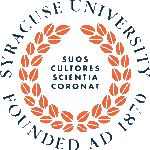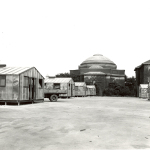Syracuse University is proud of its historical commitment to serving our nation’s veterans. In 2014, Chancellor and President Kent Syverud reaffirmed SU’s commitment to become “the best place for veterans.” The Office of Veterans and Military Affairs was formed to spearhead this mission.
Download a PDF of the Timeline of Veterans at Syracuse.
Historic Overview
World War I

Syracuse University’s commitment to veterans and military students goes back at least as far as World War I, when we established a Students Army Training Corps (SATC). In the summer and fall of 1918, the Students Army Training Corps, part of a federal government military training program, dominated much of life on campus. Winchell Hall, Archbold Gymnasium, and fraternity and sorority houses were converted to barracks. The University built a large mess hall between Sims and Bowne Halls. Members of the SATC took basic training and classes in auto mechanics, telegraphy, and carpentry as well as surveying, foreign languages, and government. Due to the Armistice, the Corps was demobilized in December of 1918, but it is estimated over a thousand men received training at Syracuse University during those brief months. These glass plate negatives show Corps members involved in various activities, such as constructing buildings and working in carpentry and telegraphy classes.
Army ROTC

Syracuse University’s Army ROTC Stalwart Battalion traces its lineage to the Students Army Training Corps. The U.S. War Department reorganized the SATC into the Reserve Officers Training Corps (ROTC) in 1919 and established a permanent military department at Syracuse University that year.
Colonel Sidney F. Mashbir, the first ROTC commander at Syracuse University, wrote “it should be the aim of Syracuse University to maintain one or more units of the Reserve Officers Training Corps (ROTC) in order that in time of national emergency there may be a sufficient number of educated men, trained in Military Science and Tactics, to officer and lead intelligently the units of the large armies upon which the safety of the country will depend.”
Photo Gallery from the Syracuse University Archives
World War II
 The Servicemen’s Readjustment Act of 1944 – better known as the GI Bill – was one of the most significant pieces of legislation ever enacted by the United States Congress. Along with other provisions, it offered a college education to millions of returning veterans, thus opening new opportunities for them and their families, changing the shape of American society and public life, and transforming the very nature of higher education.The response to the bill was far greater than anyone had predicted. Between 1945 and 1950, the GI Bill supported some 2.3 million students, most of whom would never have been able to get a college education without it.
The Servicemen’s Readjustment Act of 1944 – better known as the GI Bill – was one of the most significant pieces of legislation ever enacted by the United States Congress. Along with other provisions, it offered a college education to millions of returning veterans, thus opening new opportunities for them and their families, changing the shape of American society and public life, and transforming the very nature of higher education.The response to the bill was far greater than anyone had predicted. Between 1945 and 1950, the GI Bill supported some 2.3 million students, most of whom would never have been able to get a college education without it.

No university in the country was more closely identified with the GI Bill than Syracuse. Chancellor William P. Tolley served on the Presidential committee whose proposal formed the basis of the legislation. Taking the lead, Tolley also announced Syracuse’s “uniform admissions program,” promising everyone entering the service that there would be places waiting for them at Syracuse when they returned. And when they did return, Syracuse was as good as its word. Although still a small university by national standards, SU ranked first in New York State and 17th in the country in veteran enrollment.
Those years were not easy for anyone – not for the veterans, who were eager (and sometimes impatient) to make up for lost time, and not for the University, which was faced with challenges beyond anything in its history.
Space was at a premium. More than 600 prefab buildings, old barracks, Quonset huts, and trailers covered the campus and surrounding areas. Even so, classrooms were crowded and housing problems were legendary. New programs and curricula had to be developed and social rules had to change. The vets had to adjust to college life, and the students who were already here had to adjust to the vets, whose attitudes were different and whose numbers were overwhelming.
This exhibition, compiled from the University’s Archives and materials contributed by alumni, documents the fact that all those things were accomplished. They were accomplished in what came to be known as Syracuse’s “Can Do Spirit” that prevailed among faculty, staff, and students alike. That spirit of innovation, commitment, and caring – born during the years between 1946 and 1950 – defined a new Syracuse University and set its course to the future. This information is provided by the Syracuse University Archives.
Air Force ROTC
 Syracuse University’s AFROTC Detachment 535 was established for the 1946-1947 academic year in accordance with US War Department General Order 124. Syracuse is one of the original 77 Air ROTC units established in 1946 by then Chief of Staff of the United States Army Dwight D. Eisenhower. It became known as Air Force ROTC after the Air Force was designated a separate service in 1947.
Syracuse University’s AFROTC Detachment 535 was established for the 1946-1947 academic year in accordance with US War Department General Order 124. Syracuse is one of the original 77 Air ROTC units established in 1946 by then Chief of Staff of the United States Army Dwight D. Eisenhower. It became known as Air Force ROTC after the Air Force was designated a separate service in 1947.
Contract Training Programs
Syracuse University has continued serving the military through offering several contract training programs for military personnel.
Air Force Institute of Technology (AFIT) Language Program
In 1951 Syracuse University contracted with the US Air Force Institute of Technology to establish the first Russian language training program for airmen run by a civilian institution. Hundreds of enlisted airmen were trained in intensive 6- to 12-month courses in Russian and other East European Slavic languages until 1971. It operated from 17 aluminum-clad prefabricated wood buildings (M-0 through M-16) along what is now Lambreth Lane on South Campus. Eight buildings were used as barracks housing for enlisted airmen assigned to AFIT Detachment One at Skytop.


In Memoriam
During the early morning hours of Jan. 6, 1959, fire broke out in barracks M-7, which housed 43 airmen. The fire spread through the wood structure quickly. Seven airmen died in the fire and 19 were hospitalized. A memorial plaque to honor those lost and injured in the fire was installed on October 4, 2013. The memorial was a joint project of Syracuse University and a group of Air Force Security Service airborne reconnaissance veterans known as the Prop Wash Gang.
Enduring Partnerships
We currently operate four military contract programs that result in students obtaining graduate degrees. The programs are offered in Comptrollership, Information Studies, Supply Chain Management, and Visual Journalism. More information about these programs can be found here.
In addition to degree-granting programs, Syracuse has a number of military focused offerings such as the following:
 The National Securities Studies (NSS) was founded in 1996 and is headquartered at top ranked Syracuse University’s Maxwell School of Citizenship and Public Affairs. It is a premier professional development program that offers executive education courses for senior civilian and military leaders who are responsible for the national security interests of their respective organizations.
The National Securities Studies (NSS) was founded in 1996 and is headquartered at top ranked Syracuse University’s Maxwell School of Citizenship and Public Affairs. It is a premier professional development program that offers executive education courses for senior civilian and military leaders who are responsible for the national security interests of their respective organizations.
 The Institute for National Security and Counterterrorism (INSCT) was established in 2003. It is a collaboration between the College of Law and the Maxwell School of Citizenship and Public Affairs.
The Institute for National Security and Counterterrorism (INSCT) was established in 2003. It is a collaboration between the College of Law and the Maxwell School of Citizenship and Public Affairs.
 A U.S. Army Signal Center Partnership was established between the iSchool at Syracuse University and the U.S. Army Signal School at the Cyber Center of Excellence (SIGCEN) to allow soldiers to transfer 9 to 15 credits from SIGCEN to the iSchool and complete the remaining requirements online for a master’s degree in Information Management or Telecommunications and Network Management.
A U.S. Army Signal Center Partnership was established between the iSchool at Syracuse University and the U.S. Army Signal School at the Cyber Center of Excellence (SIGCEN) to allow soldiers to transfer 9 to 15 credits from SIGCEN to the iSchool and complete the remaining requirements online for a master’s degree in Information Management or Telecommunications and Network Management.
Recognizing that a new generation of veterans would be entering the university, Syracuse University has launched the following initiatives to serve their needs:
 The Veterans Resource Center was opened in July 2009 to assist prospective and current students with Veterans Administration and University business matters and provide a welcoming space for veterans on campus. The office and Veterans Lounge is located at 700 University Ave.
The Veterans Resource Center was opened in July 2009 to assist prospective and current students with Veterans Administration and University business matters and provide a welcoming space for veterans on campus. The office and Veterans Lounge is located at 700 University Ave.
![]() The Syracuse Veteran’s Writers Group was founded in 2010 to help veterans write stories of life in and out of the military.
The Syracuse Veteran’s Writers Group was founded in 2010 to help veterans write stories of life in and out of the military.
 The Institute for Veterans and Military Families (IVMF) was founded in June 2011. It is the first national center in higher education to focus on the social, economic, education and policy issues affecting veterans and their families post-service.
The Institute for Veterans and Military Families (IVMF) was founded in June 2011. It is the first national center in higher education to focus on the social, economic, education and policy issues affecting veterans and their families post-service.
 The College of Law opened the Veterans Legal Clinic on January 8, 2015. The Clinic will benefit our veterans and community by assisting with VA claims, representing clients in VA Claim appeals, and helping veterans in upgrading discharges. Priority status will also be given to veterans in existing Clinics, such as Family Law, Bankruptcy, Criminal Defense, Disability Law, Elder Law, Tax Law, and Consumer Law.
The College of Law opened the Veterans Legal Clinic on January 8, 2015. The Clinic will benefit our veterans and community by assisting with VA claims, representing clients in VA Claim appeals, and helping veterans in upgrading discharges. Priority status will also be given to veterans in existing Clinics, such as Family Law, Bankruptcy, Criminal Defense, Disability Law, Elder Law, Tax Law, and Consumer Law.

The Office of Veteran and Military Affairs was established on January 19, 2015, to serve as Syracuse University’s single point of entry for all veteran and military related programs and initiatives. It collaborates and coordinates with all stakeholders to best serve veterans, military connected students, and military family members at Syracuse University.






